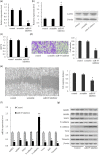LINC01088 regulates the miR-95/LATS2 pathway through the ceRNA mechanism to inhibit the growth, invasion and migration of gastric cancer cells
- PMID: 35728587
- PMCID: PMC9228637
- DOI: 10.1177/03946320221108271
LINC01088 regulates the miR-95/LATS2 pathway through the ceRNA mechanism to inhibit the growth, invasion and migration of gastric cancer cells
Abstract
Background: In gastric cancer, a malignant condition with a dismal prognosis, long non-coding RNAs (LncRNAs) play a significant regulatory role. They often compete with microRNAs through the ceRNA mechanism to affect the expression of target mRNA. However, the specific clinical value and mechanism of action of LncRNA in gastric cancer are still unclear. Methods: This study detected the expression and clinical value of LINC01088 in gastric cancer tissues. Furthermore, the biological functions of LINC01088 and the regulation mechanism of the miR-95/LATS2 pathway were explored.Results: LINC01088 and LATS2 mRNA expression decreased, and miR-95 increased in gastric cancer tissues. LINC01088 has an excellent positive correlation with LATS2 mRNA, which may be a ceRNA pair; LINC01088 has binding sites with miR-95. Gene interference tests on gastric cancer cell lines revealed that LINC01088 could prevent gastric cancer cells from proliferating, invading, and migrating. The function of LINC01088 is achieved by regulating the miR-95/LATS2 pathway through the ceRNA mechanism.Conclusion: The results of this study show that LINC01088 expression is significantly reduced in gastric cancer tissues and cell lines. LINC01088 inhibits gastric cancer cells' proliferation, invasion, and migration by regulating the miR-95/LATS2 pathway via the ceRNA mechanism.
Keywords: LINC01088; gastric cancer; invasion; large tumor suppressor kinase 2; microRNA-95; migration; proliferation.
Conflict of interest statement
Figures







Similar articles
-
LINC01088/miR-22/CDC6 Axis Regulates Prostate Cancer Progression by Activating the PI3K/AKT Pathway.Mediators Inflamm. 2023 Jul 19;2023:9207148. doi: 10.1155/2023/9207148. eCollection 2023. Mediators Inflamm. 2023. PMID: 37501932 Free PMC article.
-
The circSNX14 functions as a tumor suppressor via the miR-562/ LATS2 pathway in hepatocellular carcinoma cells.J Mol Histol. 2023 Dec;54(6):593-607. doi: 10.1007/s10735-023-10157-2. Epub 2023 Oct 20. J Mol Histol. 2023. PMID: 37861952
-
YAP1 enhances cell proliferation, migration, and invasion of gastric cancer in vitro and in vivo.Oncotarget. 2016 Dec 6;7(49):81062-81076. doi: 10.18632/oncotarget.13188. Oncotarget. 2016. PMID: 27835600 Free PMC article.
-
N6-methyladenosine (m6A)-mediated up-regulation of long noncoding RNA LINC01320 promotes the proliferation, migration, and invasion of gastric cancer via miR495-5p/RAB19 axis.Bioengineered. 2021 Dec;12(1):4081-4091. doi: 10.1080/21655979.2021.1953210. Bioengineered. 2021. PMID: 34288797 Free PMC article.
-
miR-135b, upregulated in breast cancer, promotes cell growth and disrupts the cell cycle by regulating LATS2.Int J Oncol. 2016 May;48(5):1997-2006. doi: 10.3892/ijo.2016.3405. Epub 2016 Feb 22. Int J Oncol. 2016. PMID: 26934863
Cited by
-
Nomogram model including LATS2 expression was constructed to predict the prognosis of advanced gastric cancer after surgery.World J Gastrointest Surg. 2024 Feb 27;16(2):518-528. doi: 10.4240/wjgs.v16.i2.518. World J Gastrointest Surg. 2024. PMID: 38463354 Free PMC article.
-
LINC01088 Targets miR-195-5p to Promote Proliferation and Migration and Reduce Apoptosis in the Inhibition of Carotid Artery Stenosis.Clin Appl Thromb Hemost. 2025 Jan-Dec;31:10760296251319281. doi: 10.1177/10760296251319281. Epub 2025 Mar 25. Clin Appl Thromb Hemost. 2025. PMID: 40129392 Free PMC article.
-
LINC01088 prevents ferroptosis in glioblastoma by enhancing SLC7A11 via HLTF/USP7 axis.Clin Transl Med. 2025 Mar;15(3):e70257. doi: 10.1002/ctm2.70257. Clin Transl Med. 2025. PMID: 40000422 Free PMC article.
References
MeSH terms
Substances
LinkOut - more resources
Full Text Sources
Medical

